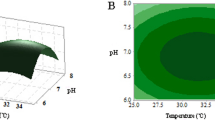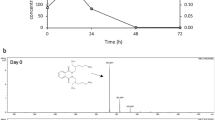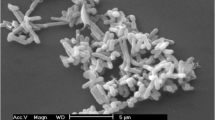Abstract
Two di-n-butyl phthalate (DBP)-degrading strains, designated as S-3 and H-2, were isolated from DBP-polluted soil and both identified as Paenibacillus sp. When DBP was provided as the sole carbon source, about 45.5 and 71.7 % of DBP (100 mg/L) were degraded by strain S-3 and H-2, respectively, after incubation for 48 h. However, DBP (100 mg/L) was degraded completely by co-culture of strain S-3 and H-2 after incubation for 60 h. Four phthalic acid (PA) esters could be utilized by co-metabolism in the study and the degradation rates followed the order of dimethyl phthalate > diethyl phthalate > DBP > dioctyl phthalate. The metabolic pathway of DBP was elucidated based on the results of metabolites identification and enzyme assays. For strain S-3, DBP was degraded into butyl hydrogen phthalate which was degraded to PA by carboxyesterase further. But PA could be not hydrolyzed further because strain S-3 lacked 3,4-phthalate dioxygenase. Different with S-3, strain H-2 could hydrolyze PA into 3,4-dihydroxy-PA by 3,4-phthalate dioxygenase. Then 3,4-dihydroxy-PA was converted to protocatechuate and benzoic acid. Finally, the aromatic ring was cleavage and mineralized to CO2 and H2O. Above all, co-metabolism could increase the activity of 3,4-phthalate dioxygenase and accelerated the degradation of DBP. This study highlights an important potential use of co-metabolic biodegradation for the in situ bioremediation of DBP and its metabolites-contaminated environment.







Similar content being viewed by others


References
An X, Zhao L (2009) Isolation and identification of a pesticide-degrading and biocontrol bacterium. Microbiology 36:1838–1841
Ash C, Priest FG, Collins MD (1993) Molecular identification of ribosomal-RNA group 3 bacilli using a PCR Probe test-proposal for the creation of a new genus Paenibacillus. J Gen Mol Microbiol 64:253–260
Bradford MM (1976) A rapid and sensitive method for the quantitation of microgram quantities of protein utilizing the principle of protein-dye binding. Anal Biochem 72:248–254
Chen JA, Liu HJ, Qiua ZQ, Shu WQ (2008) Analysis of di-n-butyl phthalate and other organic pollutants in Chongqing women undergoing parturition. Environ Pollut 156:849–853
Eaton RW (2001) Plasmid-encoded phthalate catabolic pathway in Arthrobacter keyseri 12B. J Bacteriol 183:3689–3703
Eaton RW, Ribbons DW (1982) Metabolism of dibutylphthalate and phthalate by Micrococcus sp. Strain 12B. J Bacteriol 151:48–57
Frascari D, Zannoni A, Fedi S, Pii Y, Zannoni D, Pinelli D, Nocentini M (2005) Aerobic cometabolism of chloroform by butane-grown microorganisms: long-term monitoring of depletion rates and isolation of a high-performing strain. Biodegradation 16:147–158
Fromme H, Küchler T, Otto T, Pilz K, Müller J, Wenzel A (2002) Occurrence of phthalates and bisphenol A and F in the environment. Water Res 36:1429–1438
Gu JG, Han BP, Duan SS, Zhao ZY, Wang YP (2009) Degradation of the endocrine-disrupting dimethyl phthalate carboxylic ester by Sphingomonas yanoikuyae DOS01 isolated from the South China Sea and the biochemical pathway. Int Biodeterior Biodegrad 63:450–455
Habe H, Miyakoshi M, Chung J, Kasuga K, Yoshida T, Nojiri H, Omori T (2003) Phthalate catabolic gene cluster is linked to the angular dioxygenase gene in Terrabacter sp. strain DBF63. Appl Microbiol Biotechnol 61:44–54
Holt JG, Krieg NR, Sneath PHA, Staley JT, Williams ST (1994) Bergey’s manual of determinative bacteriology, 9th edn. Williams and Wilkins, Baltimore, pp 626–640
Iwagami SG, Yang K, Davies J (2000) Characterization of the protocatechuic acid catabolic gene cluster from Streptomyces sp. strain 2065. Appl Environ Microbiol 66:1499–1508
Khan Z, Kim SG, Jeon YH (2008) A plant growth promoting rhizobacterium, Paenibacillus polymyxa strain GBR-1, suppresses root-knot nematode. Bioresour Technol 99:3016–3023
Kim Y, Istok JD, Semprini L (2004) Push-pull tests for assessing in situ aerobic cometabolism. Ground Water 42:329–337
Li J, Shu WQ, Chen JA, Qiu ZQ (2005) Studies on isolation, identification and degradation characteristics of DBP-degradation strain CQ0302. Chin Environ Sci 25:47–51
Liu HY, Huan HL, Wang YW, Li JH, Zhou YM (2007) Molecular identification of a microcystin-degrading bacteria strain S3 and its biodegradation of microcystin. Environ Sci 27:1145–1150
Luo ZH, Huang XL, Ye DZ (2008) Advances in research of biodegradation of environmental endocrine disruptors-phthalate esters. Chin J Appl Environ Biol 14:890–897
Marchesi JR, Sato T, Weightman AJ, Martin TA, Fry JC, Hiom SJ, Wade WG (1998) Design and evaluation of useful bacterium-specific PCR primers that amplify genes coding for bacterial 16S rRNA. Appl Environ Microbiol 64:795–799
Patil NK, Kundapur R, Shouche YS, Karegoudar TB (2006) Degradation of a plasticizer, di-n-butylphthalate by Delftia sp. TBKNP-05. Curr Microbiol 52:225–230
Paul D, Chauhan A, Pandey G, Jain RK (2004) Degradation of p-hydroxybenzoate via protocatechuate in Arthrobacter protophormiae RKJ100 and Burkholderia cepacia RKJ200. Curr Sci 87:1263–1268
Staples CA, Peterson DR, Thomas F, Adams WJ (1997) The environmental fate of phthalate esters: a literature review. Chemosphere 35:667–749
Tamura K, Dudley J, Nei M, Kumar S (2007) MEGA4: molecular evolutionary genetics analysis (MEGA) software version 4.0. Mol Biol Evol 24:1596–1599
Wu XL, Jin DC, Chao WL, Liang RX, Li Q, Yang Y, Qiu GZ (2009) Isolation and identification of four DBP-degrading strains and molecular cloning of the degradation genes. Environ Sci 30:2722–2727
Xu XR, Li HB, Gu JD (2005) Biodegradation of an endocrine-disrupting chemical di-n-butyl phthalate ester by Pseudomonas fluorescens B-1. Int Biodeterior Biodegrad 55:9–15
Acknowledgments
This work was supported by grants from Science and Technology Plan Projects of Zhejiang Province, China (2012F20026, 2012C13005) and the Open Project Program of Marine Fishery Institute of Zhejiang Province (2009F40G5020017).
Author information
Authors and Affiliations
Corresponding author
Rights and permissions
About this article
Cite this article
Jin, L., Sun, X., Zhang, X. et al. Co-Metabolic Biodegradation of DBP by Paenibacillus sp. S-3 and H-2. Curr Microbiol 68, 708–716 (2014). https://doi.org/10.1007/s00284-014-0533-8
Received:
Accepted:
Published:
Issue Date:
DOI: https://doi.org/10.1007/s00284-014-0533-8


